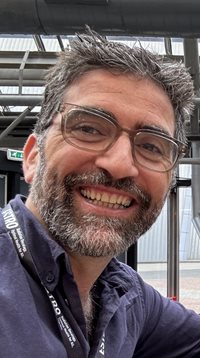ESTRO 2024 Congress report
By the ESTRO gynaecological focus group
This exciting session, which was held on the Sunday morning halfway through this year’s Congress, was focused on the management of elderly and frail patients who have gynaecological cancer.
First, our colleague Dr Majo Pakiz from Slovenia started the session with her talk: "Challenges and dilemmas in elderly gynaecological patients." She emphasised the importance of global management of such patients: consideration of their prognoses, their tolerance to treatment and how we can estimate the benefit of such treatment. We know that frailty and advancing age are factors that lead to poor prognoses; frailty must be assessed thoroughly, as it has been shown that frail patients are more intolerant of systemic treatment than are those who are robust, especially from the haematological point of view, and they experience more postoperative complications and more treatment stoppages (Ferrero et al., Int J Gynecol Cancer, 2023). Finally, she talked about the quality of these patients’ lives; it may have been preserved or increased, but it is also difficult to measure this!! In this population, there are challenges and dilemmas because these patients are not represented in clinical trials and currently there is no culture of evaluating older patients before any treatment.
Secondly, Dr Alexandra Taylor, from the UK, spoke on “patients with cervical cancer in a situation of frailty and advanced age”. She showed that in European (German) and American (Surveillance, Epidemiology and End Results, SEER) registers, cervical cancer patients aged more than 65 years represented 25% of all patients, but those on the German register had a lower five-year overall survival rate than did those under 65 years of age (46% vs. 76%) and among those on the SEER register, 15% of them had received only best supportive care. She discussed how these patients should be treated – probably with adaptation of the treatment to the stage (early or advanced) of the cancer and each patient’s general fitness level. Dr Taylor revealed that older patients received less chemotherapy than younger patients, and likewise less brachytherapy, due to the greater toxicity they experienced with age compared with the benefit they could gain. She described a wide field that required exploration, such as the effect of adaptation of doses to spare organs at risk; moderate use of hypofractionation; and the potential of palliative radiotherapy.
Thirdly, Dr Carien Creutzberg talked on the topic: “Should we treat elderly and frail endometrial cancer patients differently?” In endometrial cancer, the population is older than other cancer populations, and therefore mortality rates are higher because most of the prognostic factors for recurrence are present in this older population. The large PORTEC studies into endometrial cancer treatments have a significant representation of patients > 70 years of age (18-46%). From a molecular point of view, patients who are older than 70 years have fewer DNA polymerase epsilon mutations and more mutations of the p53 protein, and therefore they have higher risks of cancer recurrence and death caused by the disease. Cellular senescence, unfavourable biology and loss of immune system function are likely to result in inferior outcomes in this population. Dr Creutzeld gave us a series of clues to follow in order to adapt treatment to this population:
- adjuvant treatment such as radiotherapy impacts the quality of life of frail and elderly patients, and their tolerance should be evaluated before prescription of such treatment;
- decisions regarding patients should take into account results that have been published in the literature;
- mild hypofractionation (even four fractions/week with one midweek rest day) is a good treatment choice;
- there is a need for clinical trials;
- prehabilitation should be considered;
- the need for specific care in this fragile subpopulation should be taken into account; and
- so should the messages of patient advocates and the patients themselves.
Finally, our colleague Dr Cordula Petersen from Germany presented on “alternative radiotherapy options and outcomes in elderly and frail vulvar cancer patients”. As in other gynaecological cancers, age in vulvar cancer is associated with a higher mortality risk as observed in the American SEER publication of 2014. In such patients, surgical treatment is often underused; it should be kept in mind that many patients do not receive adjuvant treatment (even if radiotherapy that is performed with quality criteria shows a benefit in disease-free survival rates), and the Danish series shows that age has a deleterious effect in vulvar cancer. In the same sense, the Dutch register shows that older patients receive less nodal surgery than younger patients. Our colleague emphasised the relevance of geriatric evaluation prior to treatment as well as the use of frailty assessment scales in these patients; she pointed out that the concept of frailty was subjective and did not always correlate with the views of a geriatrician. However, under-treatment was found to increase rates of disease-free survival.
In conclusion, this is a specific population that is not widely represented in the literature; many of these patients are undertreated both surgically and by radiotherapy and chemotherapy, and some locations such as the endometrium exhibit more aggressive biological characteristics than other sites. However, this may be because more data is available for this site than for others such as the cervix or vulva. Similarly, the concept of frailty is not well defined; scales that are designed to measure it are coupled to age, yet frailty may be linked to other factors.
For these reasons, more studies are needed and greater attention paid to the appropriate care of patients if we are to increase survival rates.

Abel Cordoba
Centre Oscar Lambret, Lille
FRANCE
ESTRO gynaecological focus group